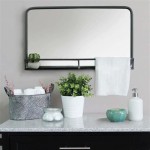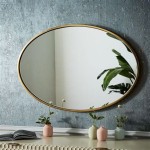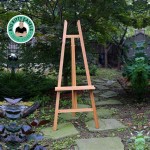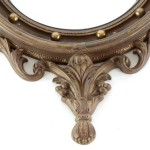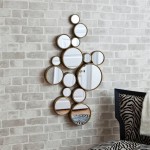How To Hang Big Mirrors
Large mirrors can dramatically enhance a room, creating an illusion of spaciousness and reflecting light to brighten the space. However, their size and weight present unique challenges when it comes to hanging them securely. This article outlines the necessary steps and considerations for successfully hanging large mirrors.
Assessment and Preparation: Before beginning, accurately measure the mirror's dimensions and weight. This information is crucial for selecting appropriate hanging hardware and ensuring the wall can support the load. Most large mirrors come with pre-installed D-rings or wire hanging systems. If the mirror lacks these, consult a professional for advice on safe attachment methods.
Choosing the Right Hanging Hardware: The hanging hardware must be rated to hold a weight exceeding that of the mirror. Heavy-duty picture hooks, D-rings, and wire are commonly used. For exceptionally heavy mirrors, consider using French cleats or mirror mounting clips designed specifically for this purpose. Consult the hardware packaging for weight limits and follow the manufacturer's instructions.
Wall Type Considerations: Different wall types require different hanging approaches. Drywall is common but may require wall anchors for heavier mirrors. For drywall, locate studs using a stud finder. Studs provide the most secure anchoring points. If hanging on plaster or masonry walls, specialized fasteners designed for these materials are necessary.
Marking and Measuring for Placement: Accurate placement is essential for a visually appealing and balanced result. Decide on the desired height and position of the mirror. Use a pencil and level to mark the wall where the top of the mirror will sit. Then, measure down from this line to determine the location of the hanging hardware based on the mirror's hanging system.
Installing the Hanging Hardware: If using D-rings or wire, ensure the wire is taut and the D-rings are securely attached to the mirror frame. For picture hooks or other wall-mounted hardware, carefully follow the manufacturer's instructions for installation. Ensure the hardware is firmly anchored into the wall or stud. When using anchors on drywall, ensure they are appropriate for the weight of the mirror.
Using French Cleats: A French cleat system provides a strong and stable mounting solution for heavy mirrors. It consists of two interlocking pieces of wood, one attached to the wall and the other to the back of the mirror. The angled design creates a secure grip and distributes the weight evenly. Ensure the cleat sections are appropriately sized and installed levelly.
Utilizing Mirror Mounting Clips: Mirror mounting clips offer another secure method, especially for frameless mirrors. These clips grip the edges of the mirror and are secured to the wall. They are typically installed along the bottom and sides of the mirror, providing a stable and discreet mounting solution. Ensure the clips are compatible with the mirror's thickness and weight.
Enlisting Assistance: Due to their size and weight, hanging large mirrors often requires assistance. An extra pair of hands can help hold the mirror in place while securing the hardware, ensuring proper alignment, and preventing accidents. This is particularly crucial for heavier or more awkwardly shaped mirrors.
Safety Precautions: Safety should be a top priority when handling large and heavy objects. Wear appropriate protective gear, including gloves and eye protection. Use a sturdy ladder or step stool when working at heights. Never attempt to lift a mirror beyond one's physical capabilities. Taking these precautions can help prevent injuries and ensure the process goes smoothly.
Post-Installation Check: Once the mirror is hung, carefully inspect the installation. Ensure the mirror is level and secure. Gently tug on the mirror to confirm the hardware is holding it firmly. Check for any gaps or instability. If any issues are detected, address them immediately to prevent the mirror from falling or becoming damaged.
Regular Maintenance: Periodically inspect the hanging hardware and wall anchors to ensure they remain secure. Tighten any loose screws or bolts. Over time, vibrations or settling can loosen the hardware, so regular maintenance is crucial for preventing accidents and ensuring the mirror remains safely mounted.
Alternative Hanging Techniques: For very large or unusually shaped mirrors, it may be necessary to consult a professional installer. They can assess the specific requirements and recommend appropriate hanging solutions. For mirrors that are too heavy for conventional hanging methods, alternative solutions such as adhesive mounting systems or custom-built supports might be required.
Dealing with Challenging Walls: Certain wall types, such as lath and plaster or brick, may present additional challenges. These walls often require specialized anchors and drilling techniques. It is important to research the specific requirements for these wall types or consult a professional for guidance.

How To Hang A Large Or Heavy Mirror

How To Hang A Heavy Mirror C R F T
How To Hang A 100 Pound Mirror On Drywall Quora

How To Hang A Heavy Mirror With Pictures Wikihow

How To Hang A Heavy Mirror

How To Hang A Large Wall Mirror Step By Tutorial

A Better Way To Hang Heavy Mirror Hanging Picture Wire

How To Hang A Heavy Mirror With French Cleat

How To Hang A Very Heavy Picture Or Mirror The Best

How To Hang A Heavy Mirror The Home Depot



